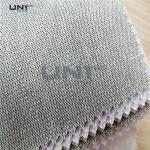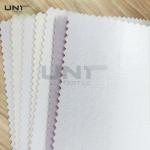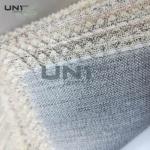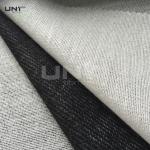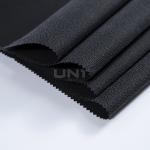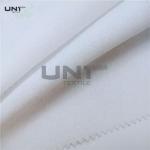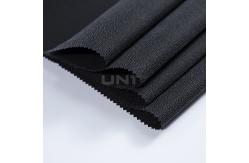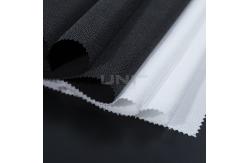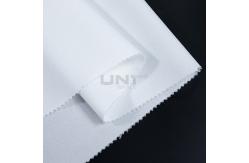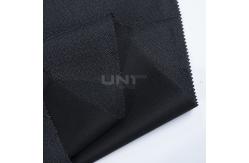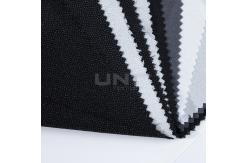Fusible interlining is a type of textile material used in garment construction to
provide additional structure, support, and shape to fabrics. It is
coated with a heat-sensitive adhesive on one side, allowing it to
bond seamlessly to the fabric when heat and pressure are applied.
Fusible interlining is widely used in both fashion and industrial
applications due to its ease of use and ability to enhance the
durability and appearance of garments. What is Fusible Interlining?Fusible interlining is made from various fibers, such as polyester,
cotton, or nylon, and is available in different weights, textures,
and finishes. It has an adhesive coating on one side that activates
when exposed to heat (often with an iron or heat press). This
adhesive bonds the interlining to the fabric, providing extra
stiffness, support, and shape without the need for additional
sewing or stitching. Benefits of Fusible InterliningEase of Application: Fusible interlining is quick and easy to apply compared to
non-fusible interlining, as it only requires heat and pressure to
bond to the fabric. This saves time and labor in garment
production. Enhanced Support and Structure: Fusible interlining helps garments maintain their shape and
structure, especially in areas like collars, cuffs, waistbands, and
plackets. It prevents sagging and ensures the garment looks crisp
and professional. Durability: The adhesive used in fusible interlining creates a strong bond
that improves the overall durability of the garment. It helps the
garment withstand wear and tear over time. Smooth Finish: Fusible interlining provides a smooth, even finish to garments,
ensuring that seams and edges are neatly pressed and don't wrinkle
easily. Versatility: Fusible interlining can be used with a wide range of fabrics,
including lightweight materials like cotton, linen, and silk, as
well as heavier fabrics like wool, polyester, and blends. It is
available in various weights and finishes, making it suitable for
different types of garments.
Types of Fusible InterliningLightweight Fusible Interlining: Used for delicate fabrics such as lightweight cotton, linen, and
silk, this type of interlining provides minimal support and is
perfect for garments like shirts, blouses, and dresses. Medium-weight Fusible Interlining: Ideal for garments requiring moderate support, such as skirts,
trousers, and jackets. It works well with fabrics like polyester,
wool blends, and denim. Heavyweight Fusible Interlining: This type is designed for fabrics that require significant
structure and support, such as coats, outerwear, and tailored
jackets. It is thicker and provides stronger shaping effects. Stretch Fusible Interlining: Stretch fusible interlining is designed for use with stretch
fabrics, ensuring that the interlining moves with the fabric. It is
often used in activewear, sportswear, and garments made from knit
fabrics. Single-Sided and Double-Sided Fusible Interlining: Some fusible interlinings are coated with adhesive on one side,
while others have adhesive on both sides. Double-sided fusible
interlining provides extra bonding strength and is often used for
more durable or heavier fabrics.
Applications of Fusible InterliningShirts and Blouses: Fusible interlining is commonly used in shirts, particularly in
collars, cuffs, and plackets. It provides structure to these areas
and ensures that they stay crisp and well-formed. Suits and Jackets: Fusible interlining is widely used in tailoring to enhance the
shape and durability of suits, jackets, and coats. It is applied to
areas such as the collar, lapel, and front panels. Outerwear: Fusible interlining is used in outerwear like coats and jackets
to add support and insulation. It helps maintain the shape of the
garment while providing added warmth and structure. Trousers and Skirts: Fusible interlining is used in the waistbands, pleats, and other
structured areas of trousers and skirts to ensure they maintain
their form. Fashion Accessories: Fusible interlining is also used in the production of fashion
accessories like hats, bags, and belts, where structure and shape
are essential. Home Textiles: Fusible interlining is used in home textile products like
curtains, cushions, and upholstery. It provides weight, support,
and helps the fabric maintain its shape.
How to Apply Fusible InterliningPre-wash Fabric: Before applying fusible interlining, it is recommended to
pre-wash the fabric to avoid shrinkage after the interlining is
applied. Cut Interlining to Size: Cut the fusible interlining to the desired size and shape,
slightly smaller than the area where it will be applied, to avoid
visible edges. Press with Heat: Place the fusible interlining on the fabric with the adhesive
side facing the wrong side of the fabric. Using an iron or heat
press, apply heat and pressure to activate the adhesive and bond
the interlining to the fabric. Make sure to follow the
manufacturer’s instructions for temperature and timing to avoid
damaging the fabric. Cool and Press Again: After the interlining has been bonded, allow it to cool before
pressing it again for a smooth, finished look.
ConclusionFusible interlining is a versatile and essential component in
garment manufacturing, offering numerous benefits such as ease of
application, enhanced structure, and durability. Whether used for
shirts, jackets, skirts, or home textiles, fusible interlining
improves the appearance and performance of fabrics while ensuring
garments maintain their shape and crispness. With different types
of fusible interlining available for various fabric types and
garment applications, it is a vital material for achieving
professional and long-lasting results in textile production |
